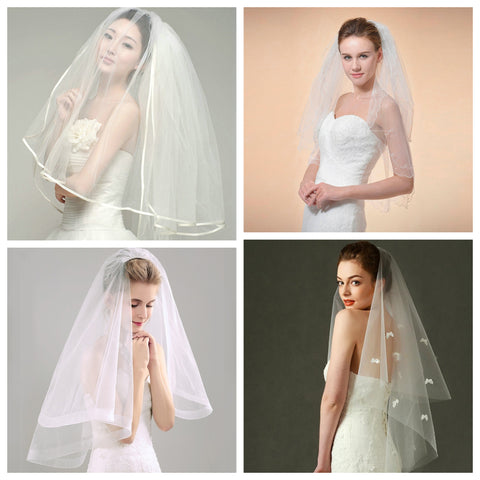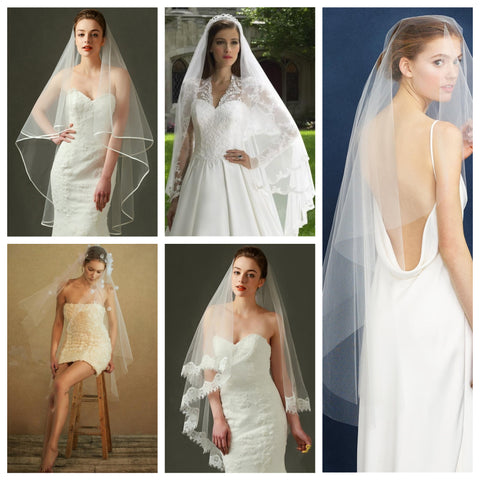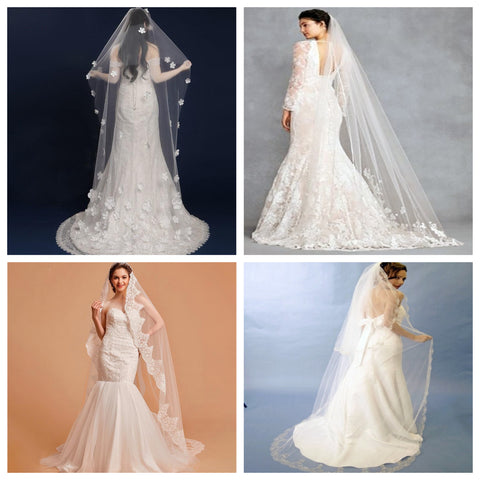Wedding Veil Guide
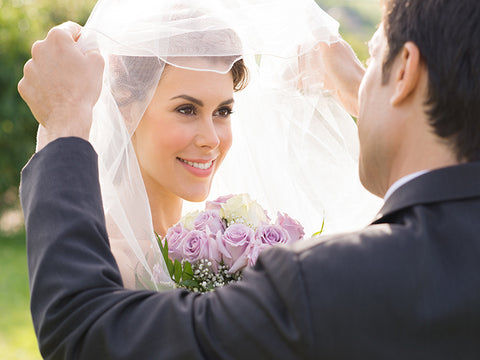
A wedding veil is perhaps the most magical of bridal accessories, as it has the power to completely transform a bridal look. The first time a bride-to-be tries on a veil with her gown can be one of the most emotional moments for her and her bridal party, for it is this moment that it really hits everyone that she is truly a bride.
In choosing your wedding veil, the most important thing to remember is that the veil should complement and enhance your wedding dress and never distract from it or compete with it. We hope the following tips and guidelines will help you choose a veil that is perfect for your dress and your own unique personal style.
Color
Wedding veils come in an array of different shades of white, ivory, beige, and even colors like blush pink. It can be a bit daunting to choose the right color to accompany your gown. This is especially true since opportunities to try them on with your gown before you buy are limited. Most bridal salons keep a very narrow selection of sample veils in basic styles for brides to try on with gowns, but most choices must be special ordered regardless of whether you buy online or in store. Given this, we aim to provide you with useful information that can make confidently choosing the right one for you easier.
The ideal is to match your gown exactly. Unfortunately, this isn’t possible for many brides unless you are able to have a veil custom made for your gown. The best rule of thumb when you can’t match exactly is to choose a veil that is slightly lighter than your gown, while ensuring the veil has the same warm or cool undertones as your gown. For example, ivory gowns have warm undertones, while true white gowns have cool undertones. Just like you want to choose a gown color that complements your own natural coloring, you want to choose a veil that compliments your gown’s coloring. It doesn’t really need to match exactly, but it needs to complement and enhance the gown.
Most of our veils are available in white, for true white gowns, and/or light ivory, which will work universally well with any shade of ivory gown since the veil will be slightly lighter than most ivory gown shades. Some of our veils are available in champagne, which is a warm, golden-cream/beige shade. These are perfect for antique or champagne colored gowns.
Finally, remember that tulle fabric is very light and transparent. The color when worn, or spread out as a single layer, will be much subtler than a swatch image that is folded with multiple layers to better show the tulle color. The more gathering and layers your veil has, the more apparent the color will be.
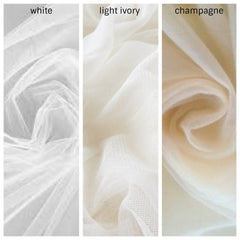
Length and Style: General Tips
In selecting the right length and style of wedding veil, there are several factors you should consider:
Your Gown
Your gown will be the primary driving factor in determining which veil length and type will be most flattering and should be strongly considered in making your decision. In most cases, we recommend that a bride-to-be purchases her gown before getting attached to a particular veil. As stated previously, you want your veil to complement and enhance your gown. However, some brides do have a specific veil or headpiece style in mind from the start. Maybe you are inspired by Kate Moss’ wedding look and know you want to wear a Juliet cap veil, or you know you want to wear a tiara and fingertip veil like Kate Middleton. In this case, we say go for it! Just be sure to, inversely, select a gown that complements the veil.
Venue and Formality
As when choosing your dress, you will also want to consider your wedding’s venue and level of formality in choosing a veil. For a casual garden or beach wedding, for example, flower crowns or flower combs/clips, as well as shorter and lighter veils, can beautifully enhance the mood and surroundings. On the other hand, if you are having a very formal church wedding, you might want to go with a more formal chapel or cathedral length veil and/or a sparkling jeweled headpiece. Of course, we are always ones to encourage brides to be original and unique. So, if you feel like bucking tradition and wearing a full-on princess tiara and cathedral veil to your daytime outdoor wedding, we say do it! Ultimately, it is your confidence and letting your unique personal style shine through that will result in the most memorable and amazing look for you.
Your Hairstyle
When you are choosing your veil, consider how you plan on wearing your hair on your wedding day. For example, drop veils, Juliet cap veils, and mantilla veils work best when hair is worn down or in low up-dos, while blushers and birdcage veils look great with almost any hairstyle. Your hairstyle might also affect where you place the veil and how you secure it. If you're wearing your hair up, you can wear the veil above or below a bun or chignon. Pinning it above gives it more volume and achieves a more classic look, while placing it below feels more modern and keeps the focus on your stylish updo. We recommend ordering your veil well in advance, so you can take it (along with any other hair accessories you plan to wear) to your trial hair appointment. You and your stylist will be able to plan the perfect way to incorporate it. Be sure to also practice how you will remove the veil without ruining your hairstyle, if you plan on doing so. It’s always a good idea to bring someone else along with you who will be in charge of helping with this.
Visual Balance
Finally, when choosing a veil, creating visual balance is the key. Certain veil lengths are best suited for certain gown lengths and shapes. For example, you may not want to choose a voluminous ballet/waltz length veil with a full-skirted ball gown. That’s a lot of volume, and the veil length will end at an awkward spot on the skirt. Voluminous veils are best with more fitted gowns. Similarly, consider balance when choosing the adornment on your veil. If you are wearing a gown with a heavily embellished bodice, do not choose a heavily embellished veil that will obscure the detailing on your bodice. Instead, choose one that is single tier \] bvx(more transparent) and either unembellished to at least the waist line or with subtle embellishments that complement those on your gown, such a matching narrow lace edge that is similar to the lace on your gown. If you are wearing a simpler gown, you can go all out with a dramatic veil. Get the idea?
Your comprehensive guide to veil styles and lengths
The Most Common Lengths:
Birdcage:
Birdcage veils are the shortest length and are typically made of Russian netting, with or without tulle. These have enjoyed huge popularity recently, as they can add a dramatic or vintage edge to your look. They are also great as an alternative to a traditional longer veil if those aren’t your thing. They are available in many styles but are usually worn just covering the eyes or extending down to the chin. Some brides wear them to the side to allow the netting to sweep across their face for a more dramatic and bold angled look. They usually attach with a comb, either one at the center or two, with one on each side of your head. In the latter case, some sort of adornment, like lace, flowers, or beading, typically cover the areas where the comb attaches.
Blusher:
This term can be confusing, as it can refer to the second tier of a longer veil that is folded forward over the face for the ceremony and lifted back before the kiss. In this case, though, we are referring to a short, single tier veil that just covers the face. They can be worn alone for a look similar to a birdcage veil, or they can be worn in addition to a long veil for the ‘unveiling’ tradition and removed after your ceremony.
Flyaway or Shoulder Length:
Shoulder length veils come in a variety of styles and end anywhere between your shoulders and waist line, while flyaway veils are typically shoulder length or shorter and gathered or double tier for fullness. These veils are perfect for achieving playful or modern look for a fashion-forward bride. They are also an excellent choice for those who are ambivalent about veils, but still want a traditional touch. The best part: these short veils will not obscure any detailing you may have on the bodice of your dress. They are best suited for short or tea length wedding dresses.
Elbow Length:
Elbow length veils generally end around the elbows or forearms, and they are an elegant and easy to handle choice, without the hassle and weight of carrying a train around all through your wedding. These are particularly gorgeous worn with a dress with a full skirt or ballgown as they end close to the point where the skirt of your gown begins, which is super-flattering and waist-defining. They are less formal, as well, so they are perfect for a more casual or daytime wedding.
Fingertip Length:
Fingertip length veils extend to the bride’s fingertips, or just above or below depending on how it is positioned in your hair. These veils are the most universally flattering and commonly worn. They flatter any body type and coordinate perfectly with most gown styles. A fingertip veil is a fabulous choice because it allows you to wear a longer veil that won’t block or distract from your gown, as you can see through the sheer fabric.
Ballet/Waltz Length:
A Ballet, or Waltz, length veil falls below the knee but above the ankle- about mid-calf. It is the perfect choice when you want the elegance and drama of a long veil, but you want to keep it on during your reception without tripping over it when you dance. This is actually why it’s called a ballet or waltz veil! This length is also not as common as some of the other lengths, which allows you to make a more unique statement. These veils look fabulous in photographs, especially when the wind catches them, making them float gracefully behind you. They look great with any hairstyle, as well.
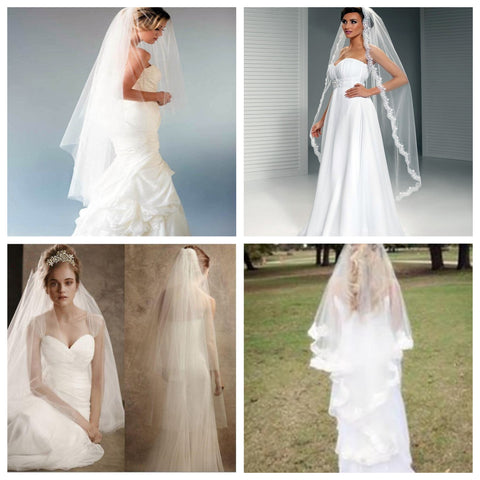 Shop Ballet/Waltz Length Veils
Shop Ballet/Waltz Length Veils
Chapel Length:
A chapel length veil is slightly longer than floor length adding drama, romance, and elegance to your walk down the aisle. These are great for formal weddings, and they are perfect for pairing with a blusher. If you’re wearing a gown with a train, the ideal situation is when your veil ends just a few inches past your gown’s train. So, chapel length veils are the best choice when your gown has a shorter train.
Cathedral Length:
The cathedral length veil was originally designed and named for cathedral and church weddings with long aisles. They are meant to be long enough to extend past a gown with a long, cathedral length train. This kind of veil makes for an ultra-dramatic entrance and is usually reserved for the most formal weddings. Of course, we always support brides doing things in unexpected ways, so you should feel free to wear this style with a trendy flower crown, headband, or a more modern dress for a unique, dreamy, and ethereal look that is gorgeous in photographs. These veils can be quite cumbersome to wear throughout your reception, though, so you might want a plan in place for removing it post ceremony. We recommend wearing a beautiful comb or hairpiece under the veil, so you still have a special bridal look when it’s dance time.
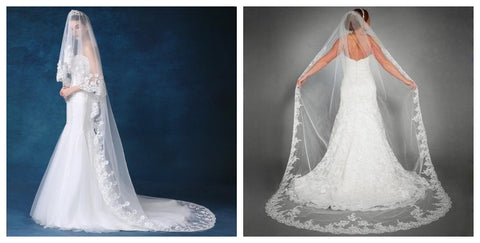
Royal Length:
A royal length veil is a version of a cathedral veil that is significantly longer, typically measuring 4 meters or more. This ultra-dramatic length looks fabulous on medium to taller brides with a very long runway to walk down. These veils can be 4 meters, or just over 157 inches long. As with a cathedral veil, you’ll want to have a plan for removing it post-ceremony, so you can move about freely at your reception. Try replacing it with an elegant hairpiece, such as a crystal or pearl comb, clip, or headband to retain your formal and glamorous bridal look.


Styles to Know
Drop Veil:
A drop veil consists of a single circular layer of tulle, which appears to have been ‘dropped’ over the wearer’s head. There is no gathering to the veil at all. The simplest drop veils do not have combs for attachment, allowing the bride to adjust the veil to the desired front and back length. In this case, we recommend attaching it with discreet hairpins the same color as your hair, or hold it in place with a tiara, headband, or flower crown. In other cases, a drop veil may have an attached hair comb sewn flat so that there is no volume, and the veil will sit flat when draped over your head. In either case, the portion that covers your face can be folded back after your ceremony for a double-tier look with less volume. The drop veil is ideal for brides that want to minimize volume, are undecided on hair style as it can be worn with any style, or want to embellish their veil with flowers, tiaras, or jewels.
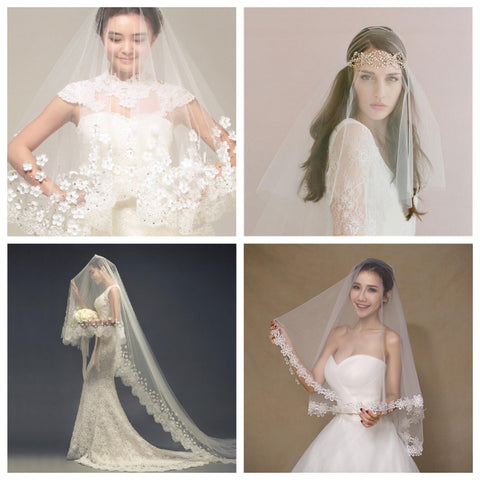
Two Tier or Double Tier Veil:
Many brides don’t understand the difference between a drop veil and a double tier veil. Double tier veils are similarly an round or oval shape piece of tulle. However, the tulle is gathered where the comb is attached. There is an attached, separately layered blusher, or the shorter second tier that is pulled over the face, and then the rest of the veil falls down your back from the comb. When the blusher is folded back away from the face, it gives the veil a beautiful waterfall effect that has a bit more volume than a drop veil would have.

Juliet Cap Veil:
The Juliet cap veil has gained a great deal of popularity in recent years, inspired by Kate Moss’ bohemian look, although not every bride will be confident enough to pull one off. A Juliet cap veil is gathered into a cap on the crown of the head and often features decorative elements at the sides or all over the cap. It is very elegant and romantic, and it is a memorable statement piece your guests will be talking about long after your big day!
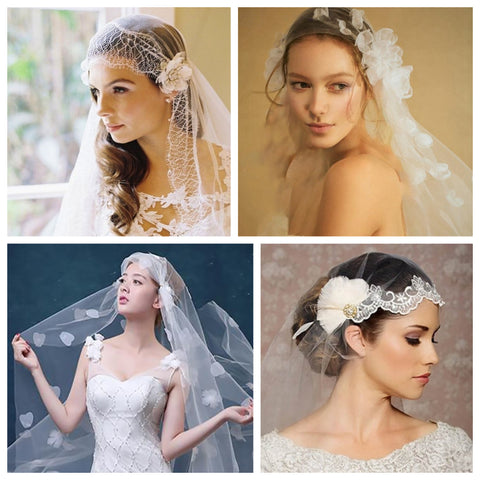
Mantilla Veil:
A mantilla veil is a traditional Spanish lace veil or tulle veil with lace edges that is worn over the head and shoulders, framing the bride and her gown beautifully. A mantilla is typically a circular or oval shaped piece of tulle or all-over lace that is not gathered and is attached toward the back of the crown with discreet hairpins. These veils are versatile, as well, though. They can also be worn as a drop veil for a ceremony blusher, or they can pinned over or under an up-do. They can even be doubled over for a dramatic two-tier effect.
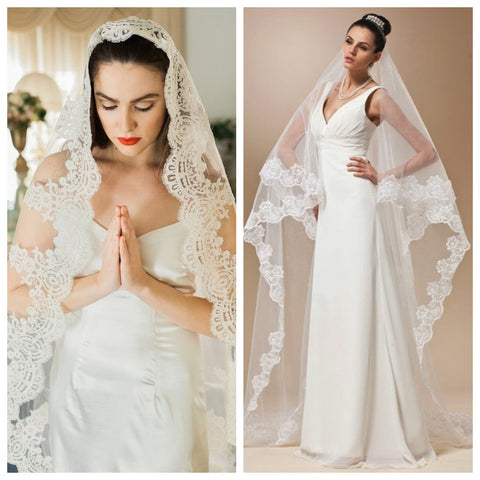
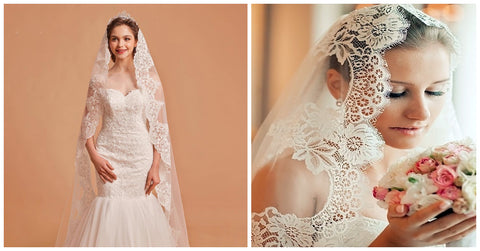
Bubble/Pouf Veil:
Bubble, or pouf, veils are made of tulle that is gathered onto a comb or hairpiece, creating a lot of volume. They come in various lengths and are certainly not for every bride, but they can look gorgeous with the right gown! They’re can also add a bit of fun, retro flair to a bridal look. These veils are bold and playful and can look stunning on a bride with an attitude to pull it off.
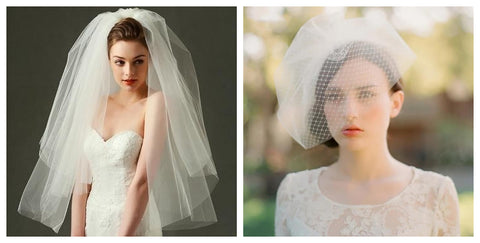

Final Note
Again, we are strong believers that a bride is always the most beautiful and memorable when she does things her own unique way. Want to wear a billowing cathedral veil with a short sheath dress? As long as you feel fabulous, do it! We provide here some guidelines, but we encourage you to be true to your own style and break ‘the rules’ when you feel it suits you best. We just want you to enable you to do so in an informed and deliberate manner. As always, we are here to help with any questions or concerns you may if you're still not sure. Just contact us, and we will get back to you promptly. Happy shopping!




